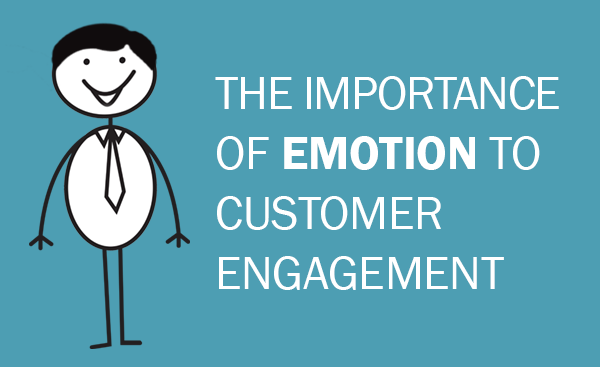The importance of emotion to customer engagement

Many studies show that people are much more emotional and less rational than we like to think. Research by Nobel prize-winning psychologist Daniel Kahneman, indicates that we have an intuitive, emotional side and a rational side when we are making decisions – and the rational side is less influential. Similarly, Steve Peters, a high profile sports psychiatrist and author of The Chimp Paradox, has identified the importance of managing emotional parts of the human ego to support performance in everyday life as well as sport.
Customer service is no different. We’ve all had good and bad customer experiences where emotional engagement (or disengagement) has radically changed the interaction. Take the example of a customer service interaction where the agent wasn’t able to resolve your issue. You may have responded more positively to an agent who showed empathy and apologized with a degree of genuine sincerity, rather than if brusquely and coldly stated that they couldn’t help you.
This is backed up by new research by Forrester. This reveals that emotion (defined as how people feel about their experience) was the #1 factor in customer loyalty across 17 of the 18 industries they analyzed. In Forrester’s report Understanding the Impact of Emotion on Customer Experience, analyst Megan Burns describes four important insights about emotional engagement that brands will have to pay attention to if they want to drive loyalty:
1. Negative experiences have a greater impact than positive ones
Negative experiences – think danger, fear, anger, frustration, worry – leave a bigger and more long lasting impression on people than positive ones. This goes back to prehistoric times, where risk aversion was essential to avoiding predators – and is still hard wired into our brain. So as a company you need to work harder to avoid negative customer experiences at all costs.
2. Emotions change experiences as they happen
When we feel intense emotions they alter our experience. This can mean, for example, that customers skip over instructions or fail to notice a feature that would easily solve their problem because they are upset or angry. A related point is that humans are prone to confirmation bias – meaning they pay more attention to evidence that supports their existing beliefs about the world (or a brand), and ignore those that prove the opposite.
3. People have selective memories about past experiences
People don’t remember every detail of an experience. Typically they’ll remember around two things about a customer service interaction – usually this is the most intense part of the experience and the very last thing that happened. So a customer might remember a call with a 5 minute hold time more favorably than one with a 2 minute hold time, if the first agent ends the call on a particularly high note.
4. We can’t always say what we’re feeling
Despite plenty of research we aren’t completely aware of what we are feeling and still don’t really understand our emotions. This means much of our experience happens at a sub conscious level that we’re totally unaware of. Hence emotion detection is an inherently incomplete field and you can’t always rely on what people tell you they’re feeling.
Building an emotional connection with customers isn’t easy. And it’s even harder in the context of digital interactions (email, chat, text, social media) as there are no verbal or physical cues to follow. Agents realize this – in Eptica’s study ‘The Power of Linguistics: Consumers vs. Agents: Can the Gap be closed?’ nearly a third (31%) of customer service agents revealed they found it hard to recognize anger or upset in written communications such as chat sessions or emails. 61% also found it hard to understand the language and vocabulary that consumers used.
So how can companies ensure they are emotionally engaging with customers? Here are four things that can help make a difference:
1. Use of linguistics
Linguistic technology can help agents understand the emotional context of digital customer communication. A good use in customer service is to automatically analyze incoming interactions (such as emails or tweets), prioritize them based on the tone of the language, forwarding to the most relevant agent or department and suggesting relevant answers. This not only helps with showing empathy, but also makes responses more immediate and personalized to the individual customer.
2. Match agent skills to tasks and reward empathy
Match the skill sets of your staff to the tasks or job roles they are assigned. Those who are naturally gifted at building rapport through conversations should be on the phone while those more comfortable at written conversations, should be managing text, chat or email customer service. You should of course ensure you recruit people that can understand your customers and show empathy – and reward them when they do this well.
3. Eradicate roadblocks on the customer journey
Analyzing what customers say and when they seek help provides first hand insight into where negative emotions occur. So spend time reviewing customer emails, calls and messages with this in mind. Where are they in the customer journey? Are there specific issues that need to be addressed? The fix could be as simple as rewriting text on your website or explaining jargon in a different way.
4. Measure the right things
You want to incentivize your team to show understanding and build a connection with customers. But how can they do this if they’re only being measured on the length of call or the number of customer email responses? While measuring productivity in straight numbers is important, you also need to look at other metrics that link to customer satisfaction to drive right behaviors.
Experts agree that much of our behavior and decisions is emotional rather than rational. Understanding emotion is therefore key for customer service success and building customer loyalty. While the rise of digital channels makes it harder to build an emotional connection with customers, the right combination of training, technology and applying insight can deliver real benefits.







Comments